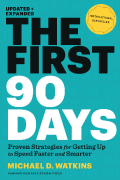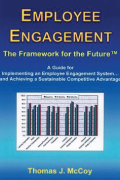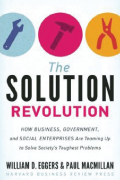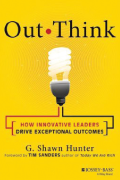TD Magazine Article
Get Off to a Good Start
A review of The First 90 Days, Updated and Expanded: Proven Strategies for Getting Up to Speed Faster and Smarter by Michael D. Watkins
Tue Oct 08 2013

The First 90 Days, Updated and Expanded: Proven Strategies for Getting Up to Speed Faster and Smarter
By Michael D. Watkins
Harvard Business Review Press, 304 pp., $19.89
Many executives fail to make it to the end of their first year on the job. This not only is devastating to the executive, but also to the organization as it tries to absorb the cost of high-level turnover or remedy the errors made by the leader during her short time on the job. As a newly hired leader, how can you ensure that your first 90 days on the job set you up for success?
The First 90 Days, originally published in 2003, was an international bestseller that was deemed the "on-boarding bible" by The Economist. This new edition guides readers through this vulnerable and risky phase of their careers, when the stakes are high and missteps can reap serious repercussions.
Author Michael Watkins, a world-renowned leadership transition expert, has adapted his classic book to reflect the changes in the business landscape during the past 10 years, such as constantly morphing organizational matrices, shorter times to market, and rising expectations.
Readers will learn how to prepare themselves for a new role, where to find critical information about the organization that will help them start adding value, a model for diagnosing and addressing inherited problems, and ways to build productive working relationships upward and laterally.
Although each chapter presents valuable information new leaders can use as they progress through their first few months on the job, there are several highlights. In chapter 3, Watkins presents a model for understanding the business situation new leaders are walking into, and how to develop an initial strategy that meets organizational needs.
Those eager to make a splash—in a good way—will probably want to skip ahead to chapter 5, "Secure Early Wins," which provides sound guidelines for honing in on what can be fixed, and fixed fast, and how to avoid ruffling feathers along the way. The final chapter, "Accelerate Everyone," makes the business case for implementing an accelerated transition program within an organization, and then presents 10 steps to doing so.
At times, The First 90 Days reads like a textbook, especially with its tables, flowcharts, and Venn diagrams. However, the information presented in the book is sound and practical, and can be put to use immediately.
Each chapter concludes with checklists and self-assessments to guide readers as they achieve early successes in their new roles, avoid common mistakes, and engage their direct reports.
Readers also can probe Watson's expertise with The First 90 Days app, available for iOS and Android devices. The app reinforces the concepts in the book with distilled nuggets of advice delivered in a variety of formats.
The First 90 Days and its digital counterpart serve as valued resources for leaders just stepping into a critical new role—when first impressions matter so much, and every word or deed can tip the scale of public opinion.
Employee Engagement: The Framework for the Future

Thomas J. McCoy
CreateSpace, 228 pp., $24.95
Employee engagement can be leveraged as a tool to improve operations. This book is a step-by-step guide to developing and sustaining engagement in a way that increases business profitability. McCoy describes a model-based systems approach and provides a variety of resources training and development practitioners can use to implement this system. There are more than 90 illustrations and diagrams that help visualize the concepts, tools, and workflows described in the book. One company implemented McCoy's system, and after 18 months saw a 10 percent improvement in engagement that correlated to the highest net profit in eight years.
The Solution Revolution: How Business, Government, and Social Enterprises Are Teaming Up to Solve Society's Toughest Problems

William D. Eggers and Paul MacMillan
Harvard Business Review Press, 273 pp., $26
Taking for its premise the long-acknowledged truth that the government alone cannot solve all the world's problems, The Solution Revolution shows how entrepreneurs all over the world are stepping forward to innovate for the public good. Using profound examples, Eggers and
MacMillan discuss how erasing traditional boundaries between the public and private sectors drives solutions to some of society's most pressing problems—such as low-cost healthcare, renewable energy, and poverty. There are incredible market opportunities to be found in these challenges. Learn how you, too, can be part of the "solution economy."
Out Think: How Innovative Leaders Drive Exceptional Outcomes

G. Shawn Hunter
Wiley, 288 pp., $24.95
As executive producer of Skillsoft's leadership video content, Hunter has collected a treasure trove of leadership experiences and insights. Out Think is the analyzed, curated compilation of these stories and ideas. which reveal how business leaders leap-frog their organizations to success. Each chapter presents a key idea, and then calls up relevant interviews with successful leaders to show how these ideas were implemented in real life. Hunter never loses sight of his readers, framing the advice in the book into actionable takeaways and thoughtfully designed tools. He shows readers how to institutionalize innovation, turn bright ideas into results, and drive profitability for their organizations.
What's on David Rock's Bookshelf?
Social: Why Our Brains Are Wired to Connect by Matt Lieberman. Lieberman examines research in social neuroscience and shows us how our need to connect with others is even more critical, and basic, than our need for food or shelter. As a result, our brain uses its spare time to learn about the social world—other people and our relationships to them.
Being Wrong: Adventures in the Margin of Error by Kathryn Schulz. This book explores why humans find it so pleasurable to be right, and so unpleasant to be wrong. Schulz shows us how our attitude toward error has a corrosive effect on our relationships, and also how it affects our creativity, and not always for the worse.
Mistakes Were Made (But Not by Me): Why We Justify Foolish Beliefs, Bad Decisions, and Hurtful Acts by Carol Tavris and Elliot Aronson. This book also is about the psychology of making mistakes, but zeros in on the ways human beings deceive themselves, and how this comes full circle to create a society where everyone has trouble acknowledging their own errors, and no one is held accountable.
